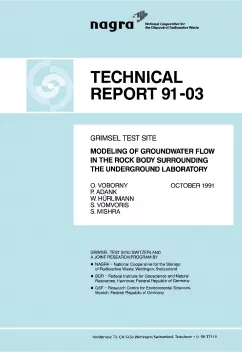
Technical Report NTB 91-03
Grimsel Test SiteModeling of groundwater flow in the rock body surrounding the underground laboratory
One of the principal objectives of the research performed at the Grimsel Test Site (GTS) is to build-up know-how in planning, execution and interpretation of underground experiments in different scientific domains. In the scope of the hydrogeologic test program, the project MOD investigates the adequate strategy in hydrodynamic modeling of groundwater flow in a fractured rock body surrounding the GTS. The specific aims of this project were, therefore, to:
- develop and test new numerical tools and techniques related to mesh generation, pre- and post-processing and to determine appropriate calibration/validation procedures and criteria
- support the interpretation of hydrologic in-situ experiments within the GTS test program and
- clarify some fundamental questions concerning the modeling of hydrodynamic effects in fractured rock around underground constructions
This report demonstrates that the adopted approach of hybrid modelling following a hierarchical model structure (different scales) is a useful method for characterization of the groundwater flow through a fractured rock massif on the regional scale (i.e. considering the large-scale anisotropy) as well as on the local scale (around underground excavation). Such modeling also provides a basis for future hydrodynamic modeling of the near-field of a rock laboratory (or repository site). The report describes the results obtained from calculations with the regional and local hydrogeologic model. A proposed calibration method is demonstrated through a simple example of the local model. The general aspects of modeling with a limited amount of data and related problems are discussed. The experience gained in project MOD shows that such modeling requires an iterative procedure with checking and updating the various model assumptions at each step.
